Australian Market Analysis: Monopoly vs. Monopolistic Competition
VerifiedAdded on 2023/06/07
|11
|2805
|118
Essay
AI Summary
This essay provides a detailed analysis of monopoly and monopolistic competition within the Australian market, highlighting the theoretical underpinnings, benefits, and drawbacks of each market structure. It examines specific examples such as Australian Post, the energy industry, and Gloria Jean's coffee to illustrate the prevalence and impact of these market structures. The essay critically assesses the effectiveness of governmental policies, particularly the Trade Practices Act, in addressing anti-competitive behavior and reducing deadweight loss. It argues that while intervention is crucial in monopoly markets, the same level of intervention may not be necessary for monopolistic markets due to the presence of close substitutes and lower barriers to entry. Furthermore, the essay points out the inefficiencies within the publicly owned energy industry, suggesting that public ownership has not effectively increased social welfare and implying potential benefits from a more competitive market structure. The study concludes by emphasizing the need for tailored policy implications to address the unique challenges posed by monopolies in Australia.
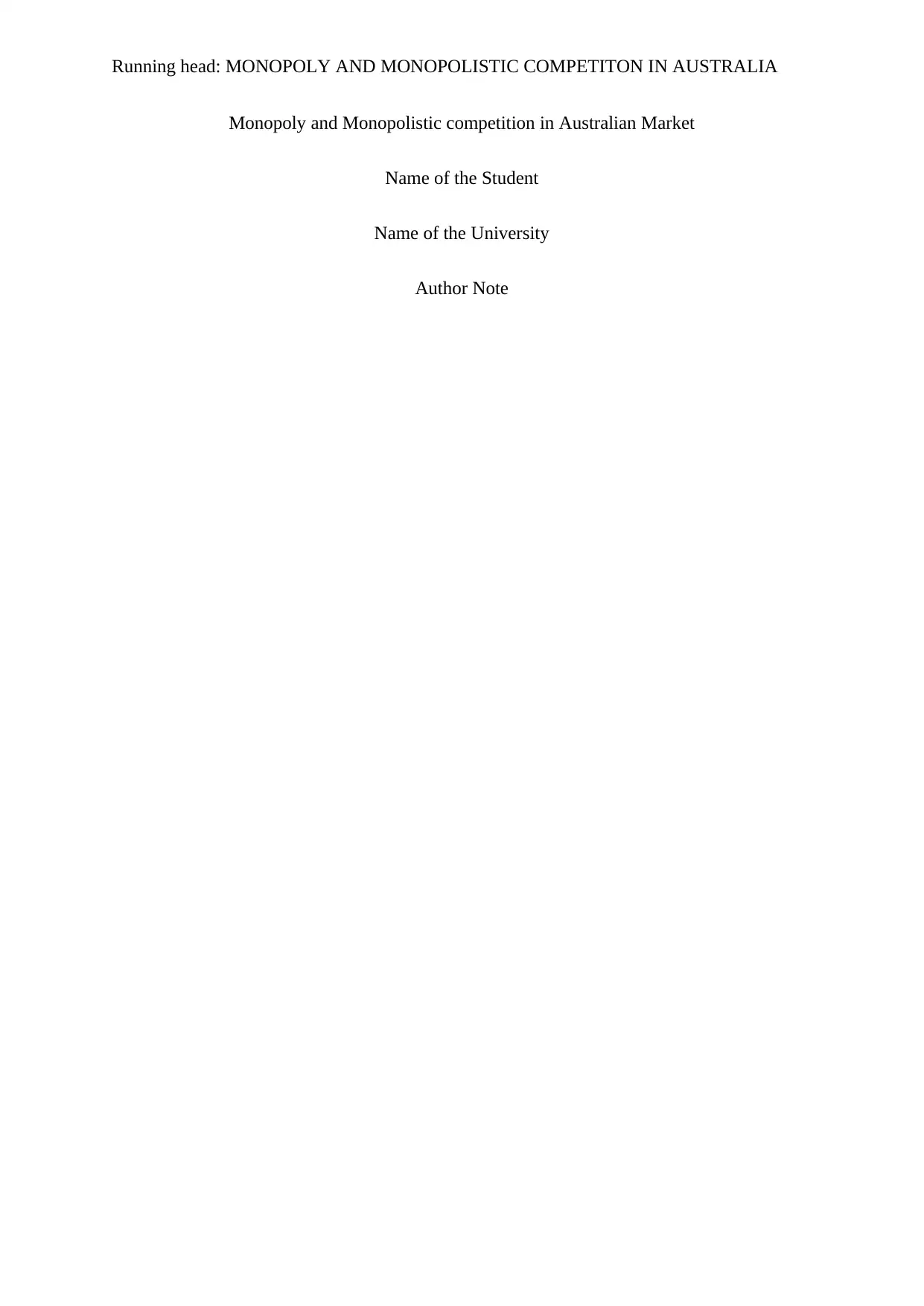
Running head: MONOPOLY AND MONOPOLISTIC COMPETITON IN AUSTRALIA
Monopoly and Monopolistic competition in Australian Market
Name of the Student
Name of the University
Author Note
Monopoly and Monopolistic competition in Australian Market
Name of the Student
Name of the University
Author Note
Paraphrase This Document
Need a fresh take? Get an instant paraphrase of this document with our AI Paraphraser
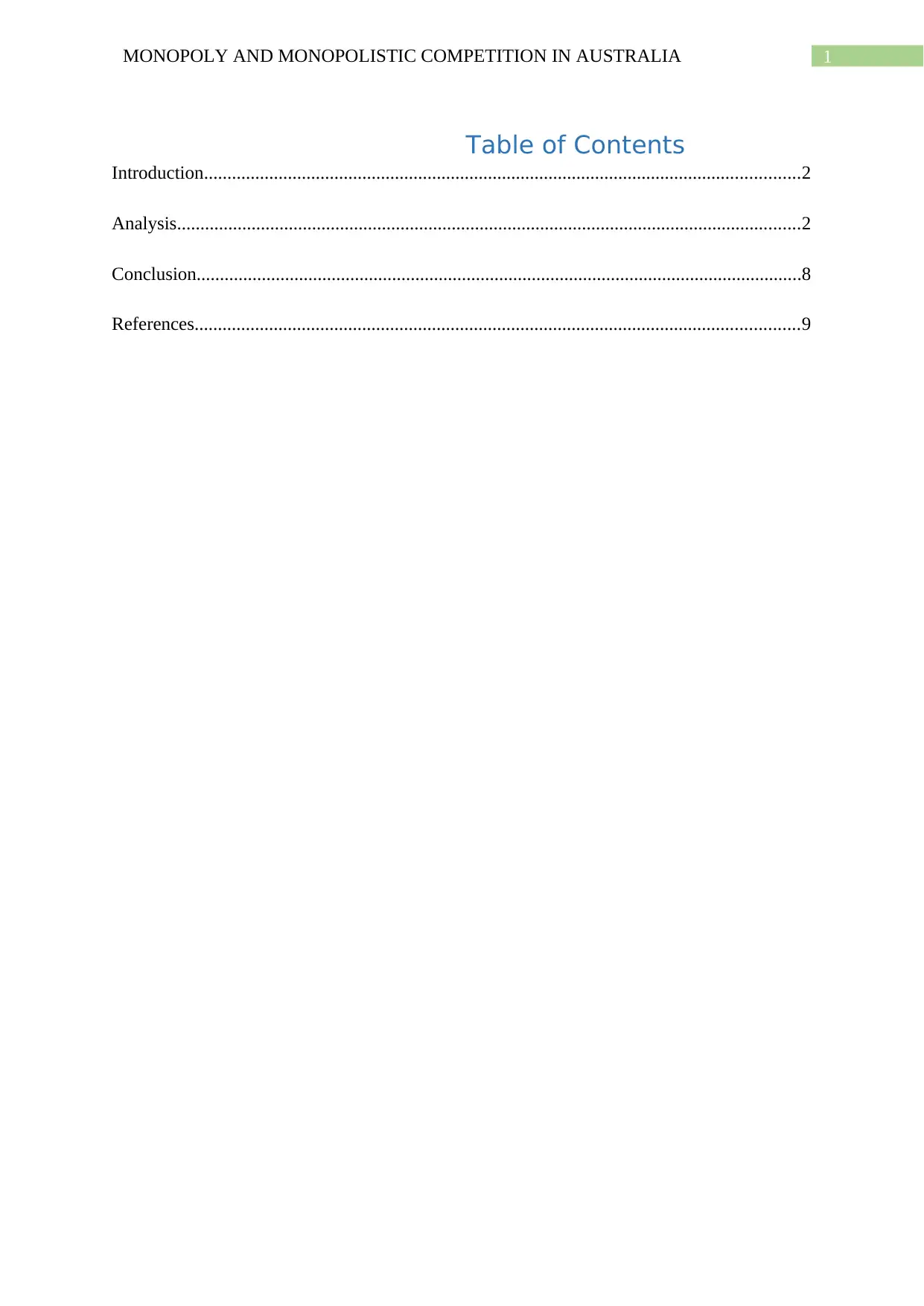
1MONOPOLY AND MONOPOLISTIC COMPETITION IN AUSTRALIA
Table of Contents
Introduction................................................................................................................................2
Analysis......................................................................................................................................2
Conclusion..................................................................................................................................8
References..................................................................................................................................9
Table of Contents
Introduction................................................................................................................................2
Analysis......................................................................................................................................2
Conclusion..................................................................................................................................8
References..................................................................................................................................9
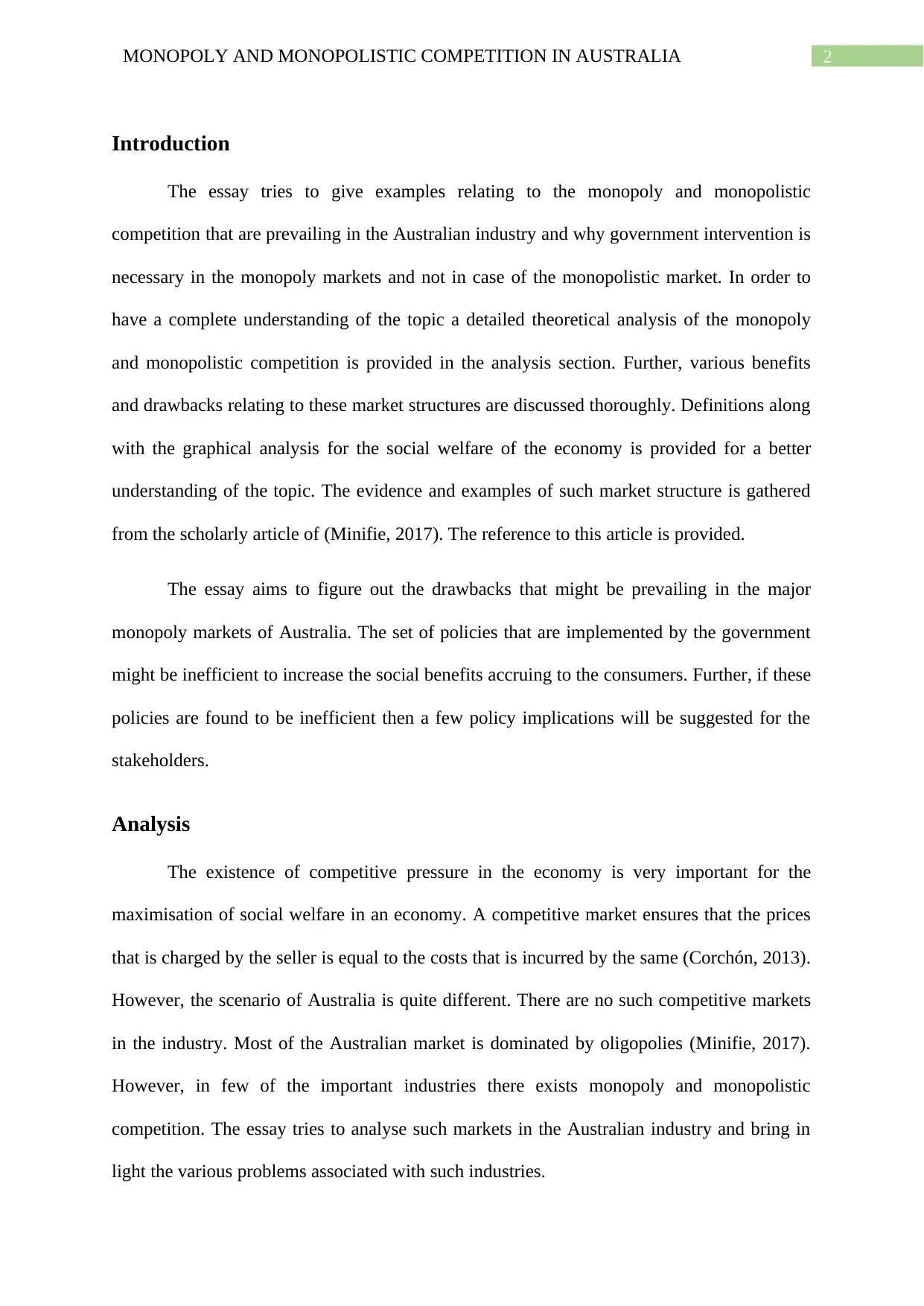
2MONOPOLY AND MONOPOLISTIC COMPETITION IN AUSTRALIA
Introduction
The essay tries to give examples relating to the monopoly and monopolistic
competition that are prevailing in the Australian industry and why government intervention is
necessary in the monopoly markets and not in case of the monopolistic market. In order to
have a complete understanding of the topic a detailed theoretical analysis of the monopoly
and monopolistic competition is provided in the analysis section. Further, various benefits
and drawbacks relating to these market structures are discussed thoroughly. Definitions along
with the graphical analysis for the social welfare of the economy is provided for a better
understanding of the topic. The evidence and examples of such market structure is gathered
from the scholarly article of (Minifie, 2017). The reference to this article is provided.
The essay aims to figure out the drawbacks that might be prevailing in the major
monopoly markets of Australia. The set of policies that are implemented by the government
might be inefficient to increase the social benefits accruing to the consumers. Further, if these
policies are found to be inefficient then a few policy implications will be suggested for the
stakeholders.
Analysis
The existence of competitive pressure in the economy is very important for the
maximisation of social welfare in an economy. A competitive market ensures that the prices
that is charged by the seller is equal to the costs that is incurred by the same (Corchón, 2013).
However, the scenario of Australia is quite different. There are no such competitive markets
in the industry. Most of the Australian market is dominated by oligopolies (Minifie, 2017).
However, in few of the important industries there exists monopoly and monopolistic
competition. The essay tries to analyse such markets in the Australian industry and bring in
light the various problems associated with such industries.
Introduction
The essay tries to give examples relating to the monopoly and monopolistic
competition that are prevailing in the Australian industry and why government intervention is
necessary in the monopoly markets and not in case of the monopolistic market. In order to
have a complete understanding of the topic a detailed theoretical analysis of the monopoly
and monopolistic competition is provided in the analysis section. Further, various benefits
and drawbacks relating to these market structures are discussed thoroughly. Definitions along
with the graphical analysis for the social welfare of the economy is provided for a better
understanding of the topic. The evidence and examples of such market structure is gathered
from the scholarly article of (Minifie, 2017). The reference to this article is provided.
The essay aims to figure out the drawbacks that might be prevailing in the major
monopoly markets of Australia. The set of policies that are implemented by the government
might be inefficient to increase the social benefits accruing to the consumers. Further, if these
policies are found to be inefficient then a few policy implications will be suggested for the
stakeholders.
Analysis
The existence of competitive pressure in the economy is very important for the
maximisation of social welfare in an economy. A competitive market ensures that the prices
that is charged by the seller is equal to the costs that is incurred by the same (Corchón, 2013).
However, the scenario of Australia is quite different. There are no such competitive markets
in the industry. Most of the Australian market is dominated by oligopolies (Minifie, 2017).
However, in few of the important industries there exists monopoly and monopolistic
competition. The essay tries to analyse such markets in the Australian industry and bring in
light the various problems associated with such industries.
⊘ This is a preview!⊘
Do you want full access?
Subscribe today to unlock all pages.

Trusted by 1+ million students worldwide
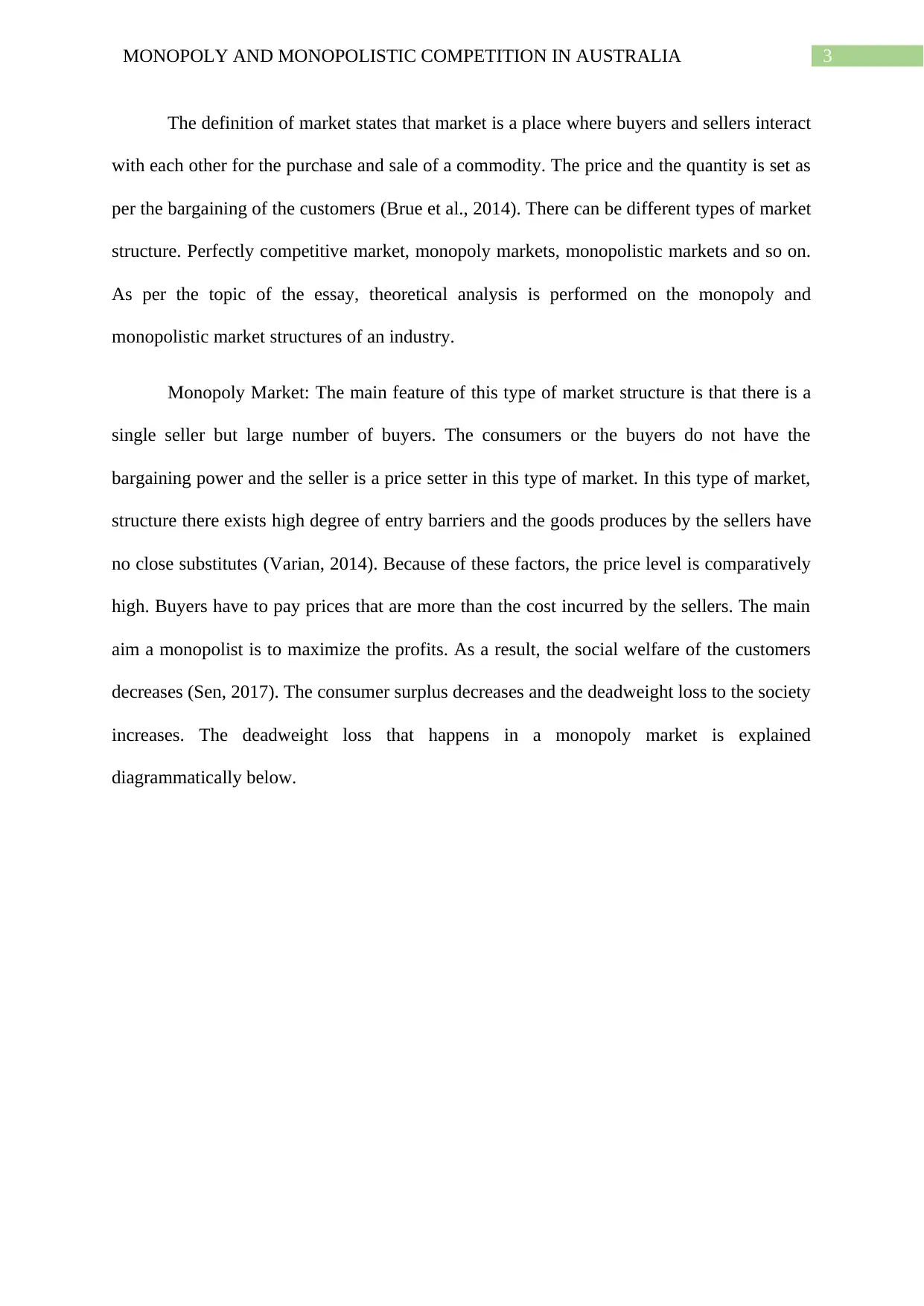
3MONOPOLY AND MONOPOLISTIC COMPETITION IN AUSTRALIA
The definition of market states that market is a place where buyers and sellers interact
with each other for the purchase and sale of a commodity. The price and the quantity is set as
per the bargaining of the customers (Brue et al., 2014). There can be different types of market
structure. Perfectly competitive market, monopoly markets, monopolistic markets and so on.
As per the topic of the essay, theoretical analysis is performed on the monopoly and
monopolistic market structures of an industry.
Monopoly Market: The main feature of this type of market structure is that there is a
single seller but large number of buyers. The consumers or the buyers do not have the
bargaining power and the seller is a price setter in this type of market. In this type of market,
structure there exists high degree of entry barriers and the goods produces by the sellers have
no close substitutes (Varian, 2014). Because of these factors, the price level is comparatively
high. Buyers have to pay prices that are more than the cost incurred by the sellers. The main
aim a monopolist is to maximize the profits. As a result, the social welfare of the customers
decreases (Sen, 2017). The consumer surplus decreases and the deadweight loss to the society
increases. The deadweight loss that happens in a monopoly market is explained
diagrammatically below.
The definition of market states that market is a place where buyers and sellers interact
with each other for the purchase and sale of a commodity. The price and the quantity is set as
per the bargaining of the customers (Brue et al., 2014). There can be different types of market
structure. Perfectly competitive market, monopoly markets, monopolistic markets and so on.
As per the topic of the essay, theoretical analysis is performed on the monopoly and
monopolistic market structures of an industry.
Monopoly Market: The main feature of this type of market structure is that there is a
single seller but large number of buyers. The consumers or the buyers do not have the
bargaining power and the seller is a price setter in this type of market. In this type of market,
structure there exists high degree of entry barriers and the goods produces by the sellers have
no close substitutes (Varian, 2014). Because of these factors, the price level is comparatively
high. Buyers have to pay prices that are more than the cost incurred by the sellers. The main
aim a monopolist is to maximize the profits. As a result, the social welfare of the customers
decreases (Sen, 2017). The consumer surplus decreases and the deadweight loss to the society
increases. The deadweight loss that happens in a monopoly market is explained
diagrammatically below.
Paraphrase This Document
Need a fresh take? Get an instant paraphrase of this document with our AI Paraphraser
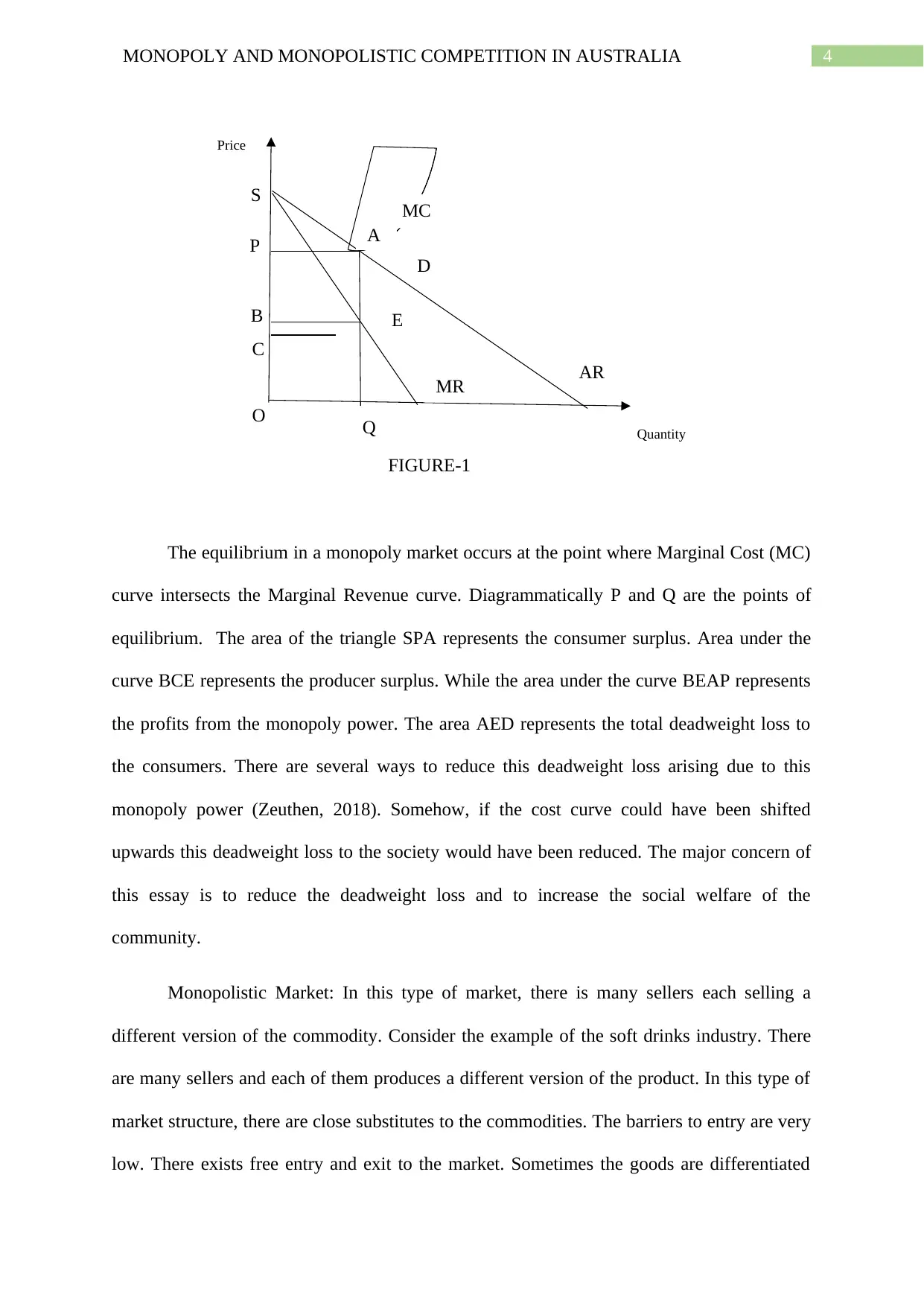
4MONOPOLY AND MONOPOLISTIC COMPETITION IN AUSTRALIA
Price
P
Q Quantity
AR
MR
A
B
C
D
E
FIGURE-1
O
MC
S
The equilibrium in a monopoly market occurs at the point where Marginal Cost (MC)
curve intersects the Marginal Revenue curve. Diagrammatically P and Q are the points of
equilibrium. The area of the triangle SPA represents the consumer surplus. Area under the
curve BCE represents the producer surplus. While the area under the curve BEAP represents
the profits from the monopoly power. The area AED represents the total deadweight loss to
the consumers. There are several ways to reduce this deadweight loss arising due to this
monopoly power (Zeuthen, 2018). Somehow, if the cost curve could have been shifted
upwards this deadweight loss to the society would have been reduced. The major concern of
this essay is to reduce the deadweight loss and to increase the social welfare of the
community.
Monopolistic Market: In this type of market, there is many sellers each selling a
different version of the commodity. Consider the example of the soft drinks industry. There
are many sellers and each of them produces a different version of the product. In this type of
market structure, there are close substitutes to the commodities. The barriers to entry are very
low. There exists free entry and exit to the market. Sometimes the goods are differentiated
Price
P
Q Quantity
AR
MR
A
B
C
D
E
FIGURE-1
O
MC
S
The equilibrium in a monopoly market occurs at the point where Marginal Cost (MC)
curve intersects the Marginal Revenue curve. Diagrammatically P and Q are the points of
equilibrium. The area of the triangle SPA represents the consumer surplus. Area under the
curve BCE represents the producer surplus. While the area under the curve BEAP represents
the profits from the monopoly power. The area AED represents the total deadweight loss to
the consumers. There are several ways to reduce this deadweight loss arising due to this
monopoly power (Zeuthen, 2018). Somehow, if the cost curve could have been shifted
upwards this deadweight loss to the society would have been reduced. The major concern of
this essay is to reduce the deadweight loss and to increase the social welfare of the
community.
Monopolistic Market: In this type of market, there is many sellers each selling a
different version of the commodity. Consider the example of the soft drinks industry. There
are many sellers and each of them produces a different version of the product. In this type of
market structure, there are close substitutes to the commodities. The barriers to entry are very
low. There exists free entry and exit to the market. Sometimes the goods are differentiated
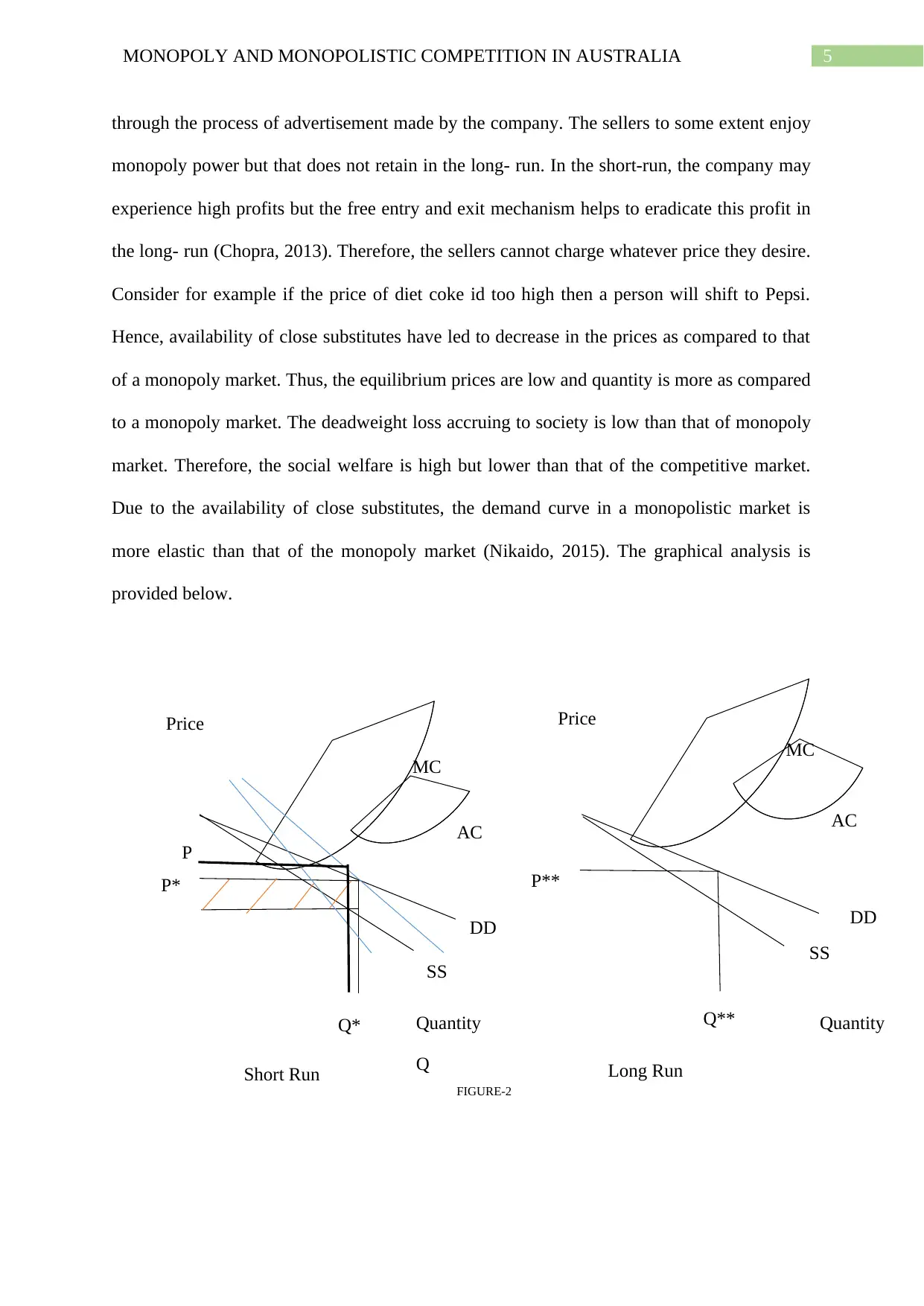
5MONOPOLY AND MONOPOLISTIC COMPETITION IN AUSTRALIA
MC
AC
DD
SS
MC
AC
DD
SS
Price
Quantity
Price
Quantity
P*
Q*
P**
Q**
Short Run Long Run
FIGURE-2
P
Q
through the process of advertisement made by the company. The sellers to some extent enjoy
monopoly power but that does not retain in the long- run. In the short-run, the company may
experience high profits but the free entry and exit mechanism helps to eradicate this profit in
the long- run (Chopra, 2013). Therefore, the sellers cannot charge whatever price they desire.
Consider for example if the price of diet coke id too high then a person will shift to Pepsi.
Hence, availability of close substitutes have led to decrease in the prices as compared to that
of a monopoly market. Thus, the equilibrium prices are low and quantity is more as compared
to a monopoly market. The deadweight loss accruing to society is low than that of monopoly
market. Therefore, the social welfare is high but lower than that of the competitive market.
Due to the availability of close substitutes, the demand curve in a monopolistic market is
more elastic than that of the monopoly market (Nikaido, 2015). The graphical analysis is
provided below.
MC
AC
DD
SS
MC
AC
DD
SS
Price
Quantity
Price
Quantity
P*
Q*
P**
Q**
Short Run Long Run
FIGURE-2
P
Q
through the process of advertisement made by the company. The sellers to some extent enjoy
monopoly power but that does not retain in the long- run. In the short-run, the company may
experience high profits but the free entry and exit mechanism helps to eradicate this profit in
the long- run (Chopra, 2013). Therefore, the sellers cannot charge whatever price they desire.
Consider for example if the price of diet coke id too high then a person will shift to Pepsi.
Hence, availability of close substitutes have led to decrease in the prices as compared to that
of a monopoly market. Thus, the equilibrium prices are low and quantity is more as compared
to a monopoly market. The deadweight loss accruing to society is low than that of monopoly
market. Therefore, the social welfare is high but lower than that of the competitive market.
Due to the availability of close substitutes, the demand curve in a monopolistic market is
more elastic than that of the monopoly market (Nikaido, 2015). The graphical analysis is
provided below.
⊘ This is a preview!⊘
Do you want full access?
Subscribe today to unlock all pages.

Trusted by 1+ million students worldwide
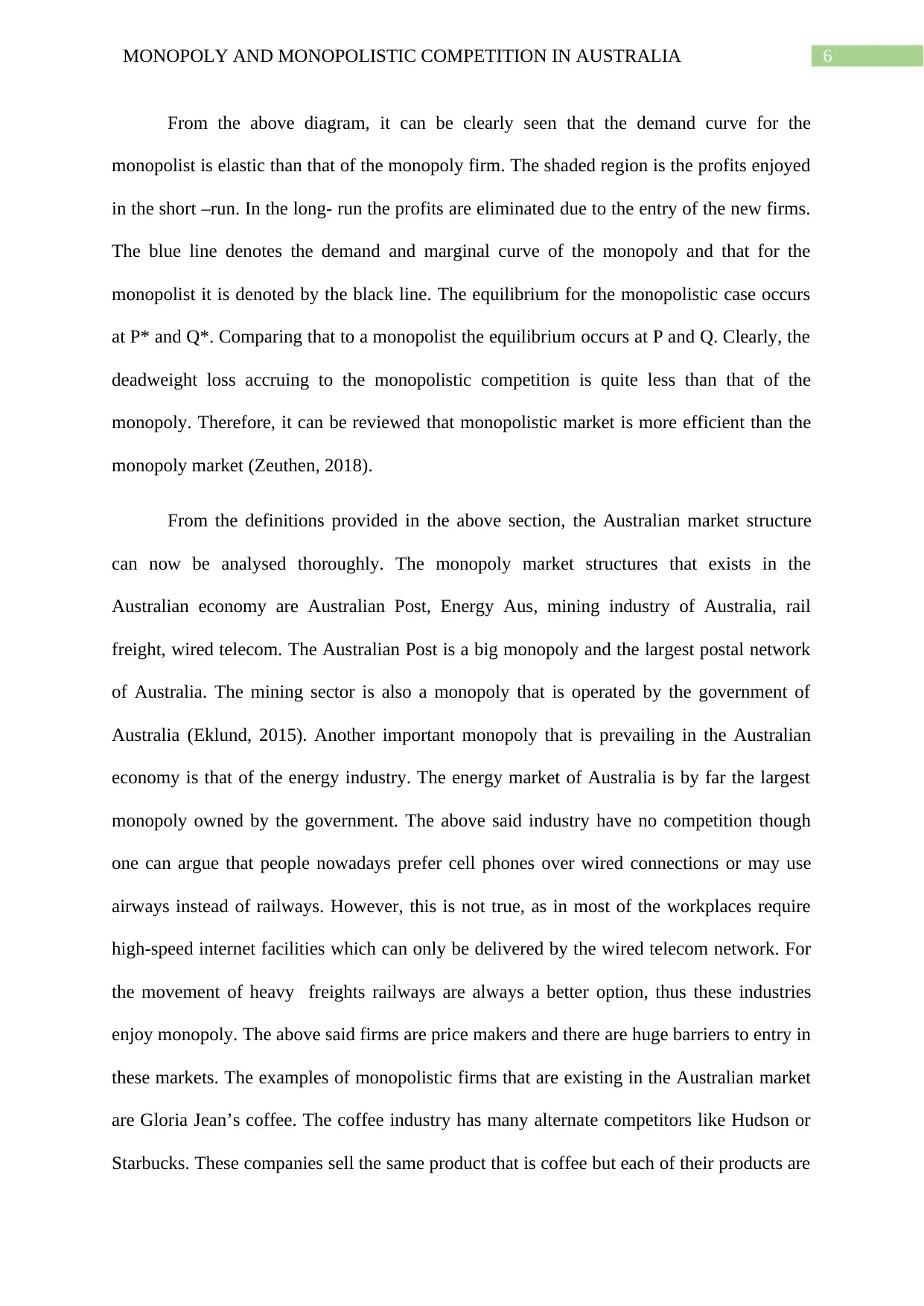
6MONOPOLY AND MONOPOLISTIC COMPETITION IN AUSTRALIA
From the above diagram, it can be clearly seen that the demand curve for the
monopolist is elastic than that of the monopoly firm. The shaded region is the profits enjoyed
in the short –run. In the long- run the profits are eliminated due to the entry of the new firms.
The blue line denotes the demand and marginal curve of the monopoly and that for the
monopolist it is denoted by the black line. The equilibrium for the monopolistic case occurs
at P* and Q*. Comparing that to a monopolist the equilibrium occurs at P and Q. Clearly, the
deadweight loss accruing to the monopolistic competition is quite less than that of the
monopoly. Therefore, it can be reviewed that monopolistic market is more efficient than the
monopoly market (Zeuthen, 2018).
From the definitions provided in the above section, the Australian market structure
can now be analysed thoroughly. The monopoly market structures that exists in the
Australian economy are Australian Post, Energy Aus, mining industry of Australia, rail
freight, wired telecom. The Australian Post is a big monopoly and the largest postal network
of Australia. The mining sector is also a monopoly that is operated by the government of
Australia (Eklund, 2015). Another important monopoly that is prevailing in the Australian
economy is that of the energy industry. The energy market of Australia is by far the largest
monopoly owned by the government. The above said industry have no competition though
one can argue that people nowadays prefer cell phones over wired connections or may use
airways instead of railways. However, this is not true, as in most of the workplaces require
high-speed internet facilities which can only be delivered by the wired telecom network. For
the movement of heavy freights railways are always a better option, thus these industries
enjoy monopoly. The above said firms are price makers and there are huge barriers to entry in
these markets. The examples of monopolistic firms that are existing in the Australian market
are Gloria Jean’s coffee. The coffee industry has many alternate competitors like Hudson or
Starbucks. These companies sell the same product that is coffee but each of their products are
From the above diagram, it can be clearly seen that the demand curve for the
monopolist is elastic than that of the monopoly firm. The shaded region is the profits enjoyed
in the short –run. In the long- run the profits are eliminated due to the entry of the new firms.
The blue line denotes the demand and marginal curve of the monopoly and that for the
monopolist it is denoted by the black line. The equilibrium for the monopolistic case occurs
at P* and Q*. Comparing that to a monopolist the equilibrium occurs at P and Q. Clearly, the
deadweight loss accruing to the monopolistic competition is quite less than that of the
monopoly. Therefore, it can be reviewed that monopolistic market is more efficient than the
monopoly market (Zeuthen, 2018).
From the definitions provided in the above section, the Australian market structure
can now be analysed thoroughly. The monopoly market structures that exists in the
Australian economy are Australian Post, Energy Aus, mining industry of Australia, rail
freight, wired telecom. The Australian Post is a big monopoly and the largest postal network
of Australia. The mining sector is also a monopoly that is operated by the government of
Australia (Eklund, 2015). Another important monopoly that is prevailing in the Australian
economy is that of the energy industry. The energy market of Australia is by far the largest
monopoly owned by the government. The above said industry have no competition though
one can argue that people nowadays prefer cell phones over wired connections or may use
airways instead of railways. However, this is not true, as in most of the workplaces require
high-speed internet facilities which can only be delivered by the wired telecom network. For
the movement of heavy freights railways are always a better option, thus these industries
enjoy monopoly. The above said firms are price makers and there are huge barriers to entry in
these markets. The examples of monopolistic firms that are existing in the Australian market
are Gloria Jean’s coffee. The coffee industry has many alternate competitors like Hudson or
Starbucks. These companies sell the same product that is coffee but each of their products are
Paraphrase This Document
Need a fresh take? Get an instant paraphrase of this document with our AI Paraphraser
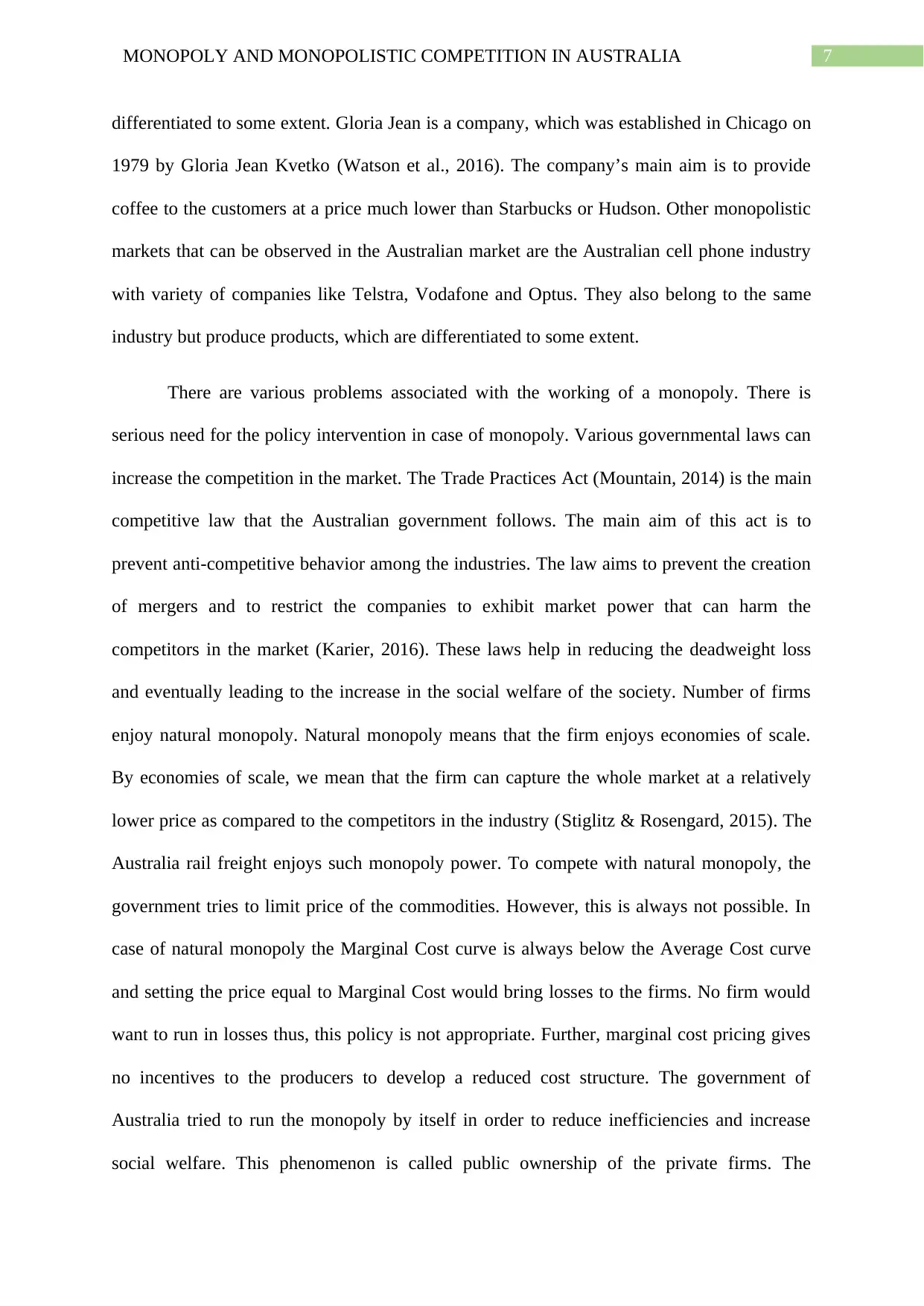
7MONOPOLY AND MONOPOLISTIC COMPETITION IN AUSTRALIA
differentiated to some extent. Gloria Jean is a company, which was established in Chicago on
1979 by Gloria Jean Kvetko (Watson et al., 2016). The company’s main aim is to provide
coffee to the customers at a price much lower than Starbucks or Hudson. Other monopolistic
markets that can be observed in the Australian market are the Australian cell phone industry
with variety of companies like Telstra, Vodafone and Optus. They also belong to the same
industry but produce products, which are differentiated to some extent.
There are various problems associated with the working of a monopoly. There is
serious need for the policy intervention in case of monopoly. Various governmental laws can
increase the competition in the market. The Trade Practices Act (Mountain, 2014) is the main
competitive law that the Australian government follows. The main aim of this act is to
prevent anti-competitive behavior among the industries. The law aims to prevent the creation
of mergers and to restrict the companies to exhibit market power that can harm the
competitors in the market (Karier, 2016). These laws help in reducing the deadweight loss
and eventually leading to the increase in the social welfare of the society. Number of firms
enjoy natural monopoly. Natural monopoly means that the firm enjoys economies of scale.
By economies of scale, we mean that the firm can capture the whole market at a relatively
lower price as compared to the competitors in the industry (Stiglitz & Rosengard, 2015). The
Australia rail freight enjoys such monopoly power. To compete with natural monopoly, the
government tries to limit price of the commodities. However, this is always not possible. In
case of natural monopoly the Marginal Cost curve is always below the Average Cost curve
and setting the price equal to Marginal Cost would bring losses to the firms. No firm would
want to run in losses thus, this policy is not appropriate. Further, marginal cost pricing gives
no incentives to the producers to develop a reduced cost structure. The government of
Australia tried to run the monopoly by itself in order to reduce inefficiencies and increase
social welfare. This phenomenon is called public ownership of the private firms. The
differentiated to some extent. Gloria Jean is a company, which was established in Chicago on
1979 by Gloria Jean Kvetko (Watson et al., 2016). The company’s main aim is to provide
coffee to the customers at a price much lower than Starbucks or Hudson. Other monopolistic
markets that can be observed in the Australian market are the Australian cell phone industry
with variety of companies like Telstra, Vodafone and Optus. They also belong to the same
industry but produce products, which are differentiated to some extent.
There are various problems associated with the working of a monopoly. There is
serious need for the policy intervention in case of monopoly. Various governmental laws can
increase the competition in the market. The Trade Practices Act (Mountain, 2014) is the main
competitive law that the Australian government follows. The main aim of this act is to
prevent anti-competitive behavior among the industries. The law aims to prevent the creation
of mergers and to restrict the companies to exhibit market power that can harm the
competitors in the market (Karier, 2016). These laws help in reducing the deadweight loss
and eventually leading to the increase in the social welfare of the society. Number of firms
enjoy natural monopoly. Natural monopoly means that the firm enjoys economies of scale.
By economies of scale, we mean that the firm can capture the whole market at a relatively
lower price as compared to the competitors in the industry (Stiglitz & Rosengard, 2015). The
Australia rail freight enjoys such monopoly power. To compete with natural monopoly, the
government tries to limit price of the commodities. However, this is always not possible. In
case of natural monopoly the Marginal Cost curve is always below the Average Cost curve
and setting the price equal to Marginal Cost would bring losses to the firms. No firm would
want to run in losses thus, this policy is not appropriate. Further, marginal cost pricing gives
no incentives to the producers to develop a reduced cost structure. The government of
Australia tried to run the monopoly by itself in order to reduce inefficiencies and increase
social welfare. This phenomenon is called public ownership of the private firms. The
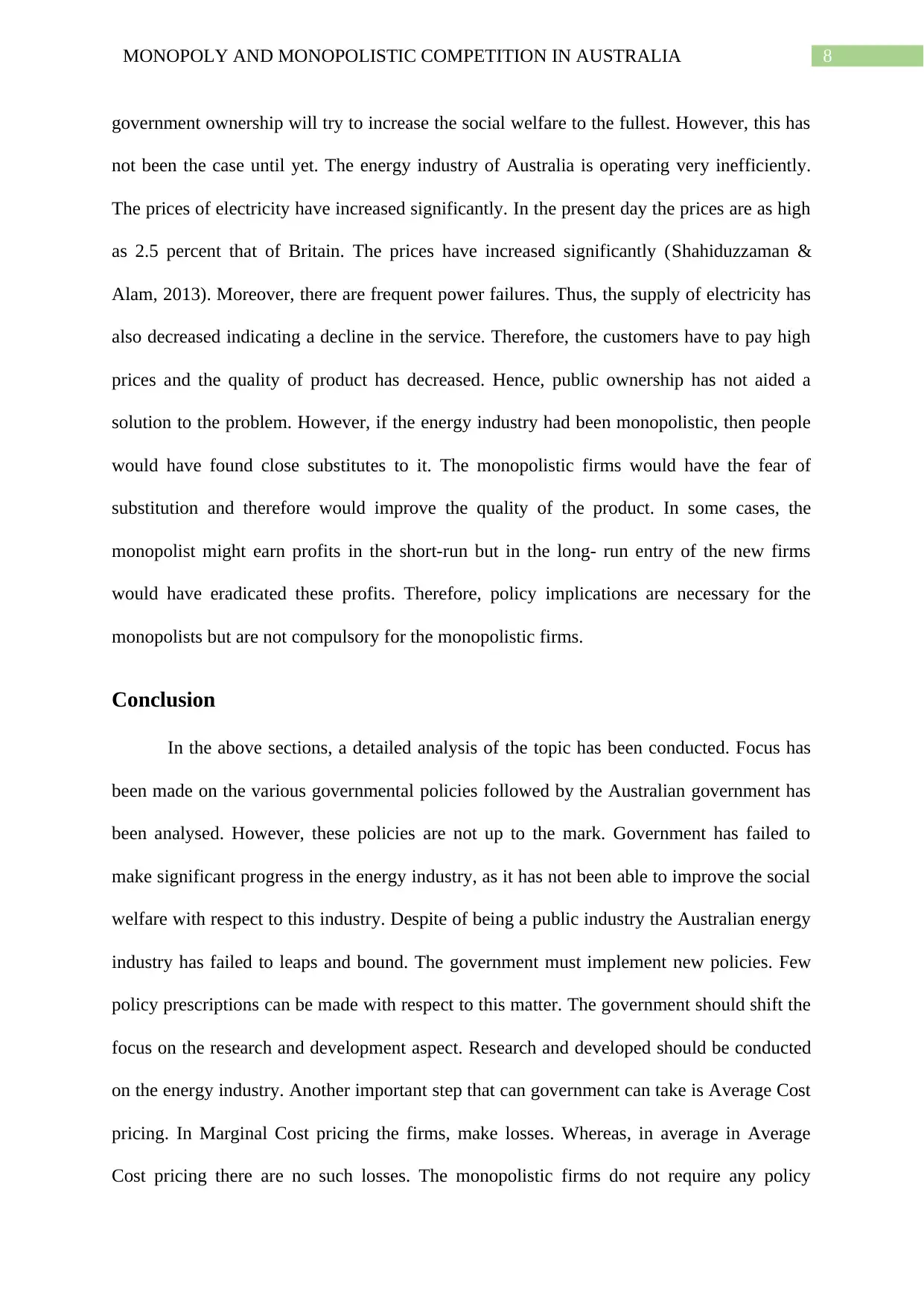
8MONOPOLY AND MONOPOLISTIC COMPETITION IN AUSTRALIA
government ownership will try to increase the social welfare to the fullest. However, this has
not been the case until yet. The energy industry of Australia is operating very inefficiently.
The prices of electricity have increased significantly. In the present day the prices are as high
as 2.5 percent that of Britain. The prices have increased significantly (Shahiduzzaman &
Alam, 2013). Moreover, there are frequent power failures. Thus, the supply of electricity has
also decreased indicating a decline in the service. Therefore, the customers have to pay high
prices and the quality of product has decreased. Hence, public ownership has not aided a
solution to the problem. However, if the energy industry had been monopolistic, then people
would have found close substitutes to it. The monopolistic firms would have the fear of
substitution and therefore would improve the quality of the product. In some cases, the
monopolist might earn profits in the short-run but in the long- run entry of the new firms
would have eradicated these profits. Therefore, policy implications are necessary for the
monopolists but are not compulsory for the monopolistic firms.
Conclusion
In the above sections, a detailed analysis of the topic has been conducted. Focus has
been made on the various governmental policies followed by the Australian government has
been analysed. However, these policies are not up to the mark. Government has failed to
make significant progress in the energy industry, as it has not been able to improve the social
welfare with respect to this industry. Despite of being a public industry the Australian energy
industry has failed to leaps and bound. The government must implement new policies. Few
policy prescriptions can be made with respect to this matter. The government should shift the
focus on the research and development aspect. Research and developed should be conducted
on the energy industry. Another important step that can government can take is Average Cost
pricing. In Marginal Cost pricing the firms, make losses. Whereas, in average in Average
Cost pricing there are no such losses. The monopolistic firms do not require any policy
government ownership will try to increase the social welfare to the fullest. However, this has
not been the case until yet. The energy industry of Australia is operating very inefficiently.
The prices of electricity have increased significantly. In the present day the prices are as high
as 2.5 percent that of Britain. The prices have increased significantly (Shahiduzzaman &
Alam, 2013). Moreover, there are frequent power failures. Thus, the supply of electricity has
also decreased indicating a decline in the service. Therefore, the customers have to pay high
prices and the quality of product has decreased. Hence, public ownership has not aided a
solution to the problem. However, if the energy industry had been monopolistic, then people
would have found close substitutes to it. The monopolistic firms would have the fear of
substitution and therefore would improve the quality of the product. In some cases, the
monopolist might earn profits in the short-run but in the long- run entry of the new firms
would have eradicated these profits. Therefore, policy implications are necessary for the
monopolists but are not compulsory for the monopolistic firms.
Conclusion
In the above sections, a detailed analysis of the topic has been conducted. Focus has
been made on the various governmental policies followed by the Australian government has
been analysed. However, these policies are not up to the mark. Government has failed to
make significant progress in the energy industry, as it has not been able to improve the social
welfare with respect to this industry. Despite of being a public industry the Australian energy
industry has failed to leaps and bound. The government must implement new policies. Few
policy prescriptions can be made with respect to this matter. The government should shift the
focus on the research and development aspect. Research and developed should be conducted
on the energy industry. Another important step that can government can take is Average Cost
pricing. In Marginal Cost pricing the firms, make losses. Whereas, in average in Average
Cost pricing there are no such losses. The monopolistic firms do not require any policy
⊘ This is a preview!⊘
Do you want full access?
Subscribe today to unlock all pages.

Trusted by 1+ million students worldwide
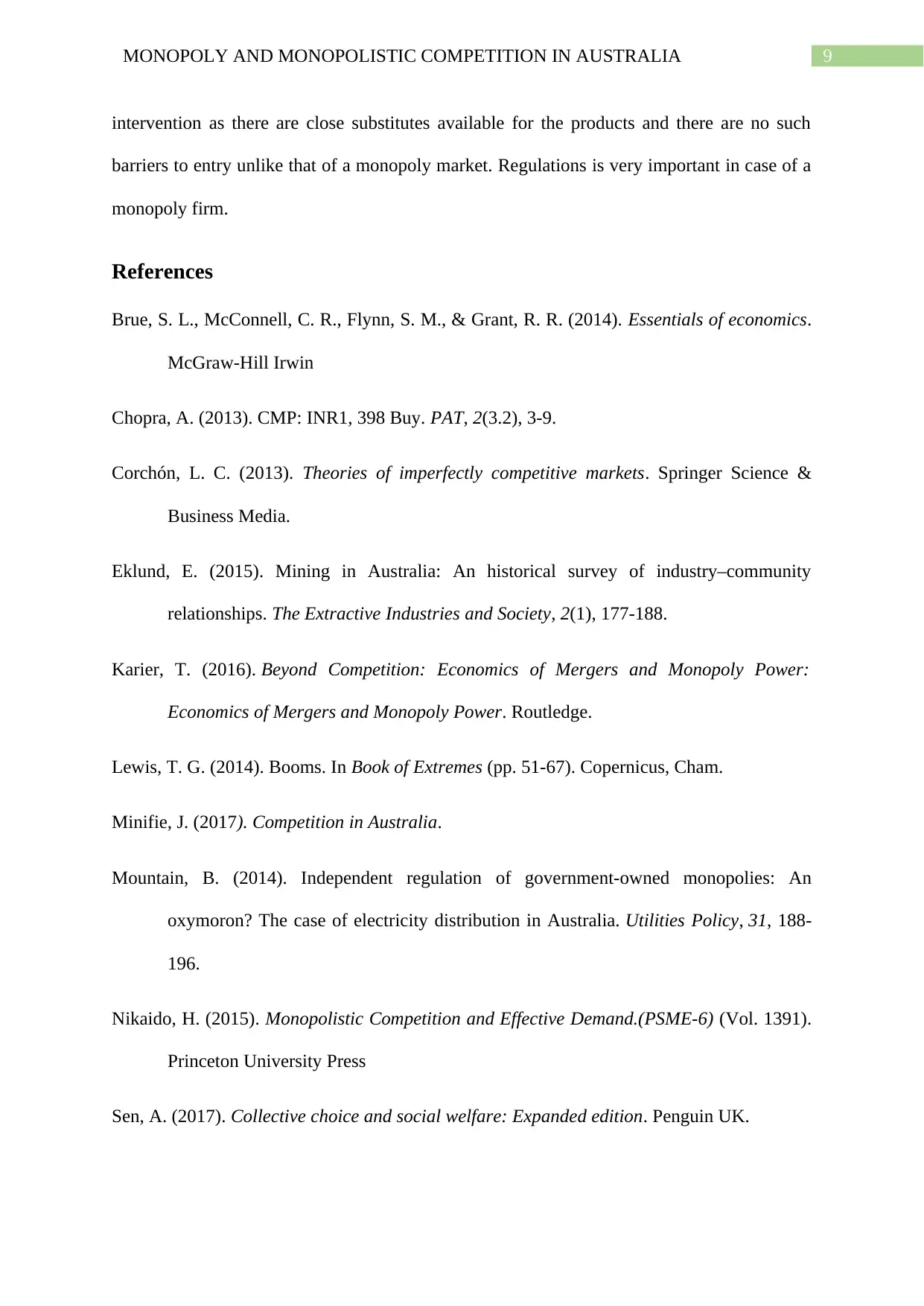
9MONOPOLY AND MONOPOLISTIC COMPETITION IN AUSTRALIA
intervention as there are close substitutes available for the products and there are no such
barriers to entry unlike that of a monopoly market. Regulations is very important in case of a
monopoly firm.
References
Brue, S. L., McConnell, C. R., Flynn, S. M., & Grant, R. R. (2014). Essentials of economics.
McGraw-Hill Irwin
Chopra, A. (2013). CMP: INR1, 398 Buy. PAT, 2(3.2), 3-9.
Corchón, L. C. (2013). Theories of imperfectly competitive markets. Springer Science &
Business Media.
Eklund, E. (2015). Mining in Australia: An historical survey of industry–community
relationships. The Extractive Industries and Society, 2(1), 177-188.
Karier, T. (2016). Beyond Competition: Economics of Mergers and Monopoly Power:
Economics of Mergers and Monopoly Power. Routledge.
Lewis, T. G. (2014). Booms. In Book of Extremes (pp. 51-67). Copernicus, Cham.
Minifie, J. (2017). Competition in Australia.
Mountain, B. (2014). Independent regulation of government-owned monopolies: An
oxymoron? The case of electricity distribution in Australia. Utilities Policy, 31, 188-
196.
Nikaido, H. (2015). Monopolistic Competition and Effective Demand.(PSME-6) (Vol. 1391).
Princeton University Press
Sen, A. (2017). Collective choice and social welfare: Expanded edition. Penguin UK.
intervention as there are close substitutes available for the products and there are no such
barriers to entry unlike that of a monopoly market. Regulations is very important in case of a
monopoly firm.
References
Brue, S. L., McConnell, C. R., Flynn, S. M., & Grant, R. R. (2014). Essentials of economics.
McGraw-Hill Irwin
Chopra, A. (2013). CMP: INR1, 398 Buy. PAT, 2(3.2), 3-9.
Corchón, L. C. (2013). Theories of imperfectly competitive markets. Springer Science &
Business Media.
Eklund, E. (2015). Mining in Australia: An historical survey of industry–community
relationships. The Extractive Industries and Society, 2(1), 177-188.
Karier, T. (2016). Beyond Competition: Economics of Mergers and Monopoly Power:
Economics of Mergers and Monopoly Power. Routledge.
Lewis, T. G. (2014). Booms. In Book of Extremes (pp. 51-67). Copernicus, Cham.
Minifie, J. (2017). Competition in Australia.
Mountain, B. (2014). Independent regulation of government-owned monopolies: An
oxymoron? The case of electricity distribution in Australia. Utilities Policy, 31, 188-
196.
Nikaido, H. (2015). Monopolistic Competition and Effective Demand.(PSME-6) (Vol. 1391).
Princeton University Press
Sen, A. (2017). Collective choice and social welfare: Expanded edition. Penguin UK.
Paraphrase This Document
Need a fresh take? Get an instant paraphrase of this document with our AI Paraphraser
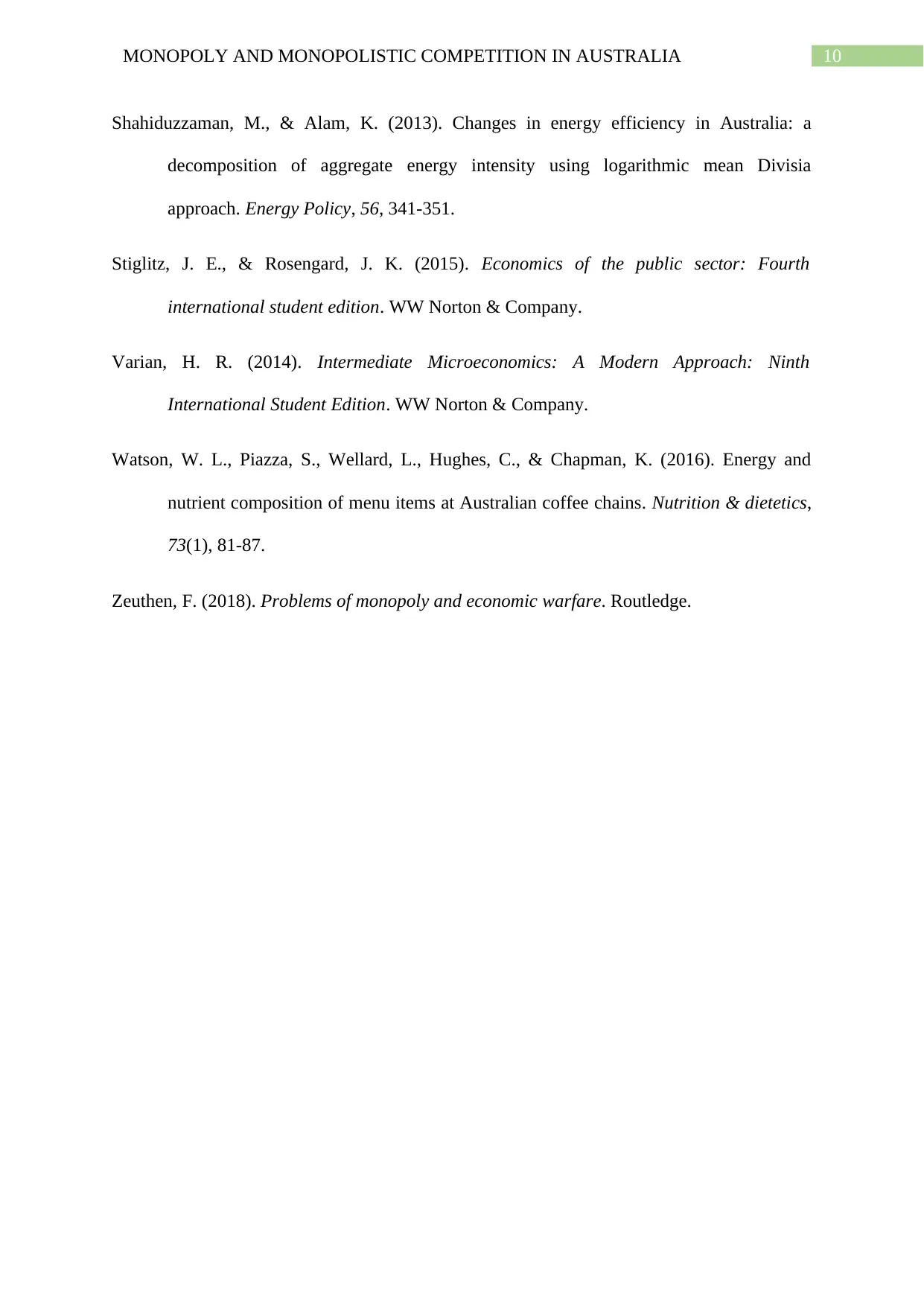
10MONOPOLY AND MONOPOLISTIC COMPETITION IN AUSTRALIA
Shahiduzzaman, M., & Alam, K. (2013). Changes in energy efficiency in Australia: a
decomposition of aggregate energy intensity using logarithmic mean Divisia
approach. Energy Policy, 56, 341-351.
Stiglitz, J. E., & Rosengard, J. K. (2015). Economics of the public sector: Fourth
international student edition. WW Norton & Company.
Varian, H. R. (2014). Intermediate Microeconomics: A Modern Approach: Ninth
International Student Edition. WW Norton & Company.
Watson, W. L., Piazza, S., Wellard, L., Hughes, C., & Chapman, K. (2016). Energy and
nutrient composition of menu items at Australian coffee chains. Nutrition & dietetics,
73(1), 81-87.
Zeuthen, F. (2018). Problems of monopoly and economic warfare. Routledge.
Shahiduzzaman, M., & Alam, K. (2013). Changes in energy efficiency in Australia: a
decomposition of aggregate energy intensity using logarithmic mean Divisia
approach. Energy Policy, 56, 341-351.
Stiglitz, J. E., & Rosengard, J. K. (2015). Economics of the public sector: Fourth
international student edition. WW Norton & Company.
Varian, H. R. (2014). Intermediate Microeconomics: A Modern Approach: Ninth
International Student Edition. WW Norton & Company.
Watson, W. L., Piazza, S., Wellard, L., Hughes, C., & Chapman, K. (2016). Energy and
nutrient composition of menu items at Australian coffee chains. Nutrition & dietetics,
73(1), 81-87.
Zeuthen, F. (2018). Problems of monopoly and economic warfare. Routledge.
1 out of 11
Related Documents
Your All-in-One AI-Powered Toolkit for Academic Success.
+13062052269
info@desklib.com
Available 24*7 on WhatsApp / Email
![[object Object]](/_next/static/media/star-bottom.7253800d.svg)
Unlock your academic potential
Copyright © 2020–2025 A2Z Services. All Rights Reserved. Developed and managed by ZUCOL.





